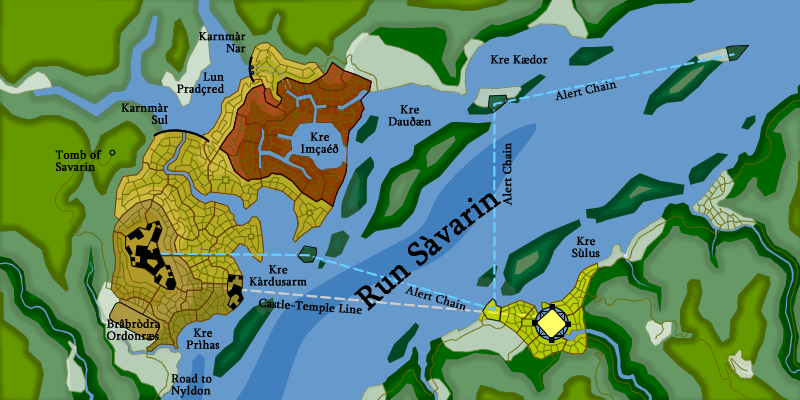The Risen City
The largest city in Ildûn, Savris is both the capital of the kingdom and hereditary seat of the Lords of Savàrið. It is named after Savàrin the White, who conquered the Isle of Ælyra on behalf of the High King. During the course of the Old Empire, Savris was an unheralded port town that served as a hub for the poor southern towns of Ildûn. It was only after the fall of Ildûn that the capital was moved. For several centuries, the capital moved to varying locations throughout the land, depending on the whim of the current rulers. Savris was eventually chosen over other locations due to its excellent bay, deep harbors, and trade potential. It didn’t hurt the city’s chances that the priests of Drāūn decided to start rebuilding their high temple at Savris in the beginning of the 5th century DR. The harbors of Savris have been filled with Burning Hand sails since the 4th century DR.
Savris has a number of epithets. It is sometimes referred to as the “Risen” or “Resurrected” City, a reference to the original capital of Ildûn. Savris is also known as the City of Colors due to the dazzling collection of stained glass windows on display throughout the city. The stained glass windows of Savris are not limited to buildings, appearing within stone arches and gateways throughout. There are so many stained glass windows that many have been positioned to create composite pictures of light at certain times of day, month, and year.
Wards
- Yrdrun (River Ward)
Landmarks
- Brâbròdra Ordonræs. One of largest structures in Savris is the hillside Brâbròdra Ordonræs. The stadium boasts a half-mile track and seating for thousands. People of all classes congregate to watch races, staged combat, and theater upon the south stage. At the northern end of the stadium is a large pool occupied by an ancient Dekàli warship. This is a full-scale replica of the ship used by Savàrin the White during his landing to the south. A Master of Games traditionally stands on the deck of the ship and announces events.
- Great Window of Drāūn. At the city’s center stands two massive stone columns connected by a massive lancet arch. Constructed within the arch are a dazzling composition of heavy stained glass depicting an army of skeletons emerging from a riverside. A number of pieces from the window are missing and filled with gray panels inscribed with Drāūni scripture. The window is believed to be one of the few remnants of original High Temple, Kyrm Orydrāūn. Pryr Drāūn hold services beneath the window on most holy days.
- Karnmàr Nar. A tall earth and stone dam that is managed with two massive stone cisterns. Water released into these cisterns is channeled beneath the city and deposited in Kre Imçaéð.
- Karnmàr Sul. A large earth and stone dam that supplies water and milling for the city. The combination of the two city dams creates a large reservoir in the hills above Savris.
- Kre Dauðæn
- Kre Imçaéð. Kre Imçaéð has become the mercantile center of Savris, ever since the Burning Hand established a post here in 371 DR. The harbor entrance is flanked by two towers that extend beneath the water’s surface. A large winch in the basement of each tower is connected to a heavy chain that lies along the bottom of the harbor entrance. When necessary, the chain can be raised to prevent passage into and out of Kre Imçaéð. Additional access to the surrounding ward is controlled by a series of gates in the ward wall.
- Kre Kædor
- Kre Kàrdusarm. New Shield Harbor.
- Kre Prìhas. Oyster Harbor.
- Kre Sùlus
- Lun Pradçred (Whiteshore Lake). Reservoir formed above Savris by two dams. The surrounding valley walls have been scarred by quarrying. The white stone extracted from these hills has been used for the dams and other structures in the city.
- Tomb of Savarin. On a grassy ridge above the Yrdrun, a ring of brilliant white standing-stones mark the resting place of the Dekàli commander Savàrin. Though the commander did not die at Savris, his body was removed from a manor crypt in Moràgyth, Hedrewyr for the city’s dedication. Today, the ring is a popular site for hikers, picnickers, and an annual ceremony of remembrance. The tomb’s location offers a wide vista of the Run Sàvarin and excellent views of the rising Kyrm Orydrāūn.
